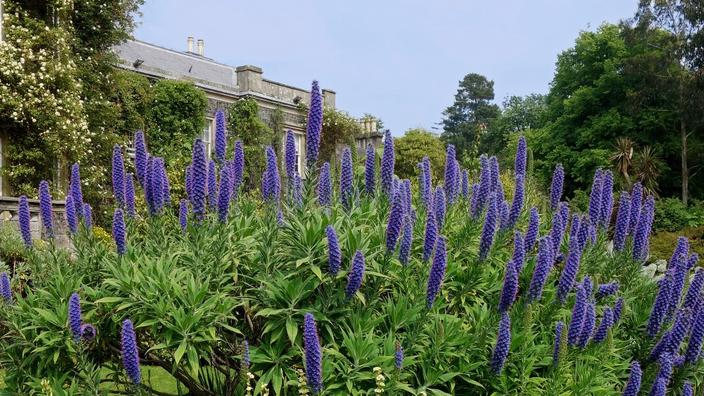Latin name:
Echium candicans
.
Botanical family
: Borraginaceae, such as comfrey, borage and heliotrope.
To discover
This month in the garden: what to plant, sow or harvest in June?
June: what are the seasonal vegetables and fruits?
What are the different types of viperine?
The genus
Echium
(
viperine
in French) is represented in France by five species, the best known of which is
E. vulgare
, a biennial plant of 30 cm to 1 m in height which flowers in late spring and early summer.
Read also: Festivals and plant festivals: the summer agenda
But several particularly spectacular species of shrub echiums grow spontaneously in the Canaries and on the island of Madeira.
Here are a few :
E. virescens
: Very branched bush, 2 m high, giving in spring long inflorescences in spikes covered with numerous blue or pink flowers.
Common in Tenerife.
E. webbii:
Branched bush 1-1.5m high giving inflorescences in lateral cymes, covered with blue flowers.
Frequent on the island of La Palma, bordering forest areas.
Spring flowering.
Requires a shady and humid exposure, but with a well-draining soil.
E. decaisnei
: Branched bush 2m high with lanceolate leaves with small thorns around the edge and along the central vein.
Conical, broad and dense inflorescence composed of numerous white flowers with blue stripes.
Common in the mountainous areas of Gran Canaria.
Spring flowering.
Uses
: Outside the Côte d'Azur and the Atlantic coast where it supports outdoor cultivation, Madeira viperine must be planted in containers.
What are the characteristics of viperine?
Origin
: Madeira Island, on the edge of the forest or on cliffs.
E. candicans
is a branched shrub 1.50 m high with branched stems covered with pubescent, lanceolate, gray-green-gray leaves.
The inflorescence, made up of numerous intense blue honey flowers, measures 30 cm in length.
To read also: The pearls of the "Rendez-vous aux jardins"
Spectacular plant from Madeira Island where it grows on the edge of the forest or on cliffs.
Blooms from late spring to early summer.
Flowering period:
End of spring, beginning of summer.
Hardiness
: Able to withstand temperatures close to 0 ° C,
E. candicans
is perfectly suited to growing in gardens along the Atlantic coast and around the Mediterranean.
Elsewhere, it must spend the winter in a frost-free and well-lit room to prevent the rosettes of leaves from withering.
How to grow viperine?
Difficulty level:
Easy.
Plant without special requirements.
For plants grown in pots, water every 5 to 10 days during the growing season (March 15 to early October) and in winter, only if necessary.
Allow the substrate to dry thoroughly before adding water again.
Read also: Garden: how to create a pretty flower bed
Soil
: For container culture, make a light, well-draining substrate, half composed of horticultural soil and silty soil and the other half of non-calcareous sand.
Exposure:
Bright and sunny.
Sowing / planting:
The propagation of Madeira viperine, like all other shrub echia, is done by seed.
Common diseases and parasites:
Few diseases if the cultivation technique is good.
Among pests, watch for aphids and mealybugs.
Where to get these plants
: in garden centers, or at specialized merchants for a larger choice.
Sheet produced by Norbert Rebmann, SNHF, section Cacti and succulents (www.snhf.org).

